Here’s a stat you’d be happy to know if you’re a founder or marketer betting on LinkedIn advertising to grow your revenue:
In 2022, LinkedIn generated $5.91 billion in advertising revenue. This number is supposed to further grow to reach $10.35 billion by 2027.
If you’re not doing it already, this is your sign to start advertising your products on LinkedIn.
And if you’re someone who has already been doing it but has questions such as:
“Why do some ads rack up clicks, leads, and praise while ours stall?”
Or, “What are high-growth startups doing differently with their LinkedIn ads?”
Then here’s the short answer for you: they understand that LinkedIn users log in to this platform with some very specific intentions — to upskill, explore industry trends, and make business decisions, not to browse memes or kill time. That means what works on Meta or X will likely fall flat here.
So what does work?
That’s exactly what this blog reveals with 11 real LinkedIn ad examples from B2B startups and enterprise brands alike. We’ll dissect what makes them successful, covering everything from ad format selection and copywriting strategy to audience targeting and performance optimization.
We’ll also address common questions and concepts like:
- What are the best LinkedIn ad formats for B2B lead generation?
- How do I write LinkedIn ad copy that people actually read?
- What LinkedIn targeting options really move the needle?
- Metrics, copy, and design breakdowns
- Platform-specific insights
Whether you’re running your first campaign or looking to squeeze better ROI from your current ones, this post will help you decode what top-performing LinkedIn ads have in common and how to make those success signals your own.
Time to unpack some seriously effective LinkedIn ad examples.
11 successful LinkedIn ad examples and what we can learn from them
1. ClickUp – AI Agents
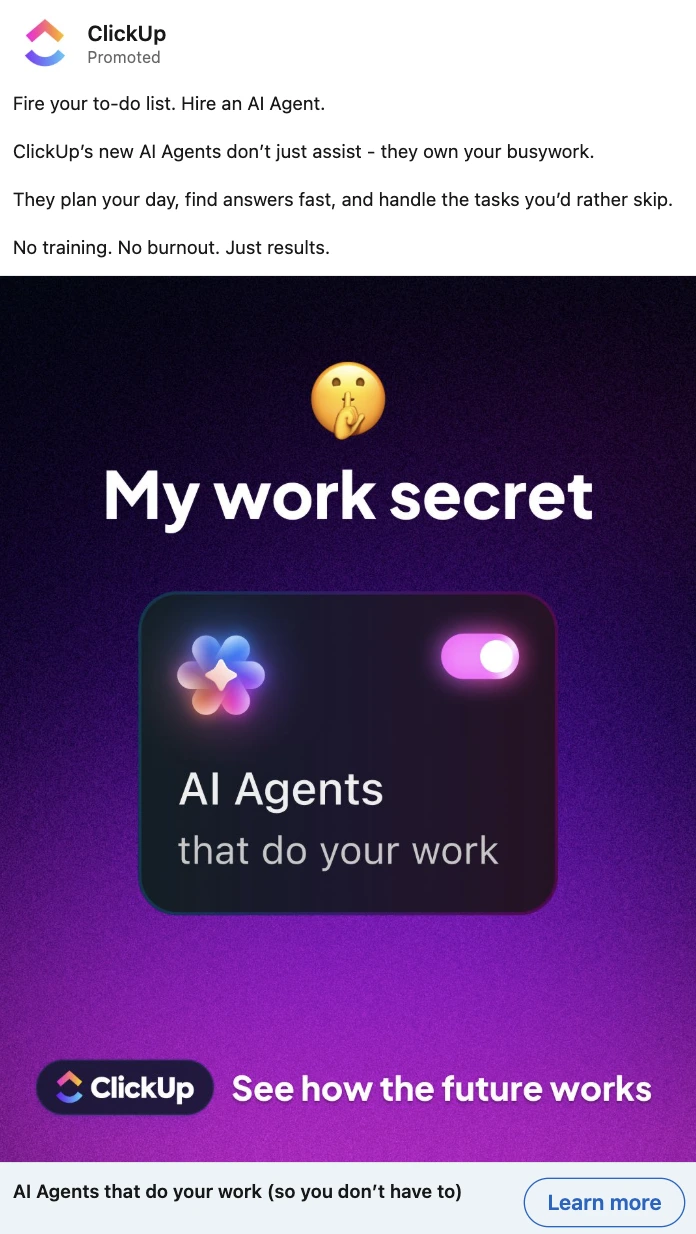
Clickup
Objective: Product awareness for new AI feature launch
Ad format: Single image ad
Why it works: Strong, benefit-first hook (“Fire your to-do list”) framed as a bold claim. The creative uses the emoji to create intrigue (“My work secret”), followed by a clear benefit copy. This combination drives high engagement from productivity-minded users, particularly early adopters of AI tools. The bold visual paired with a clear CTA or Call-to-action (“Learn more”) supports mid-funnel clicks.
What you can learn: Lead with a transformation-based claim (“hire an AI agent”), then reinforce it with specific, low-friction benefits. The copy should be tight, rhythmic, and non-technical — ideal for decision-makers without needing deep AI context.
2. Klaviyo – Klaviyo vs. Attentive
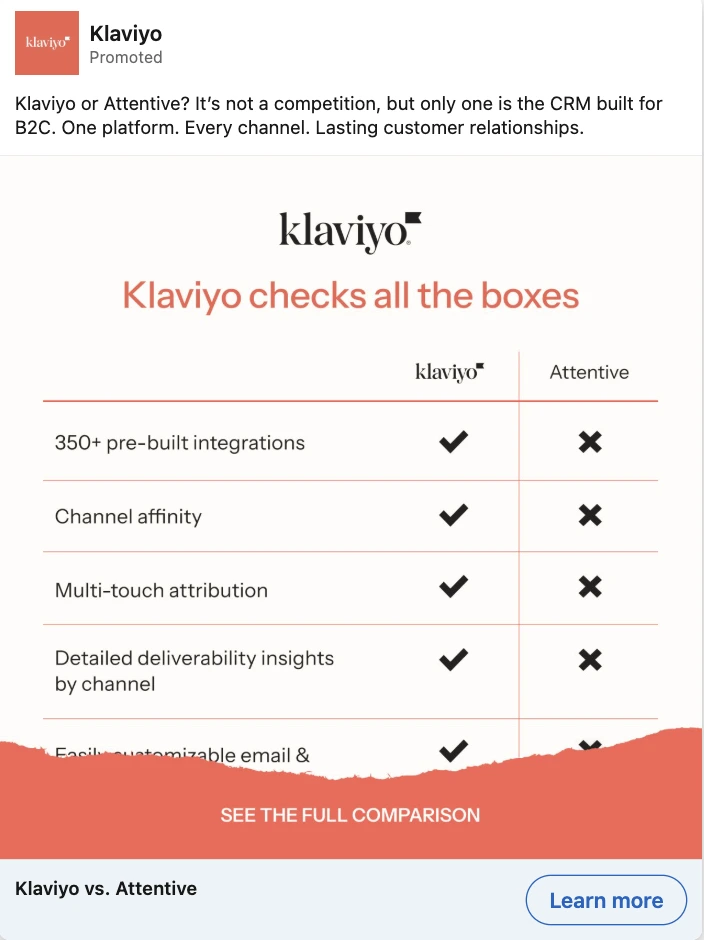
Klaviyo
Objective: Competitive positioning to win over B2C CRM buyers
Ad format: Static comparison image
Why it works: The ad uses a comparison chart: a proven visual format that simplifies decision-making. Copy reinforces clarity without trashing the competitor. “It’s not a competition, but…” cleverly frames the comparison without being overtly aggressive. This type of creative-copy combination has high click-through potential among B2C marketers comparing tools. The “See the full comparison” CTA also invites curiosity.
What you can learn: Head-to-head comparisons can convert consideration-stage users, especially when the format is visual, scannable, and subtly confrontational.
3. Mutiny – No dev bottlenecks
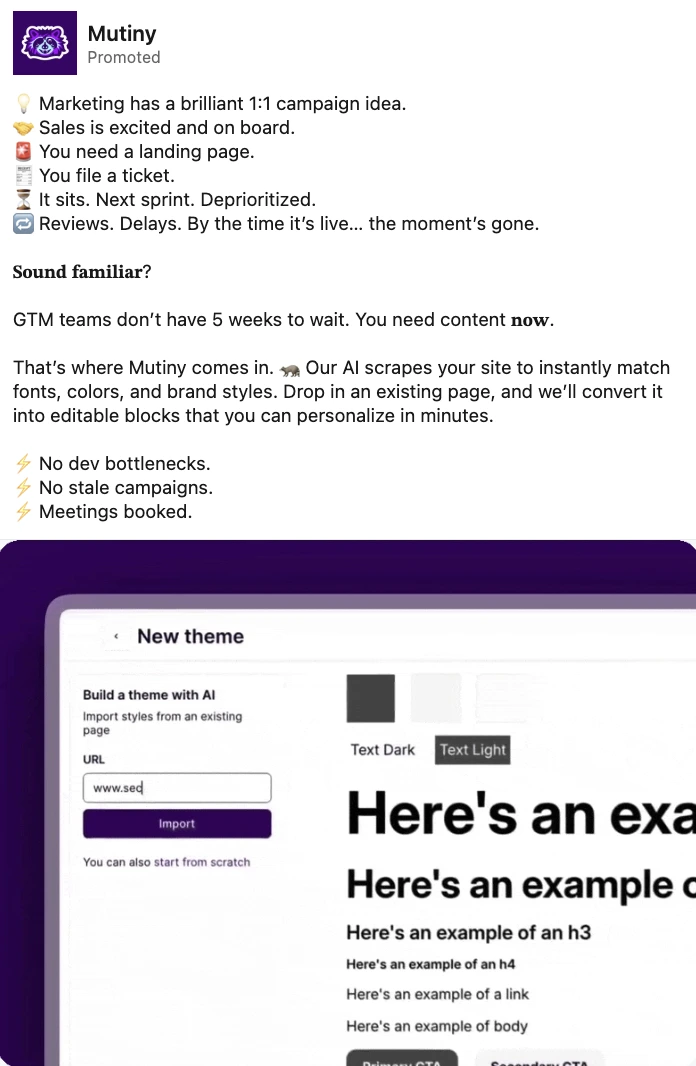
Mutiny
Objective: Mid-funnel education and product demo interest
Ad format: Image ad with product demo visual
Why it works: The copy uses a narrative-style framework to walk through a common GTM bottleneck, highlighting internal dysfunction that resonates deeply with cross-functional teams. The punchy “Sound familiar?” reset turns empathy into urgency. This type of ad performs well with demand gen and product marketers facing content creation speed issues.
What you can learn: Use real, sequence-based problems your target audience experiences. Using the storytelling structure increases retention, and the “now” urgency reframes the pain.
4. Mixpanel – EA case study
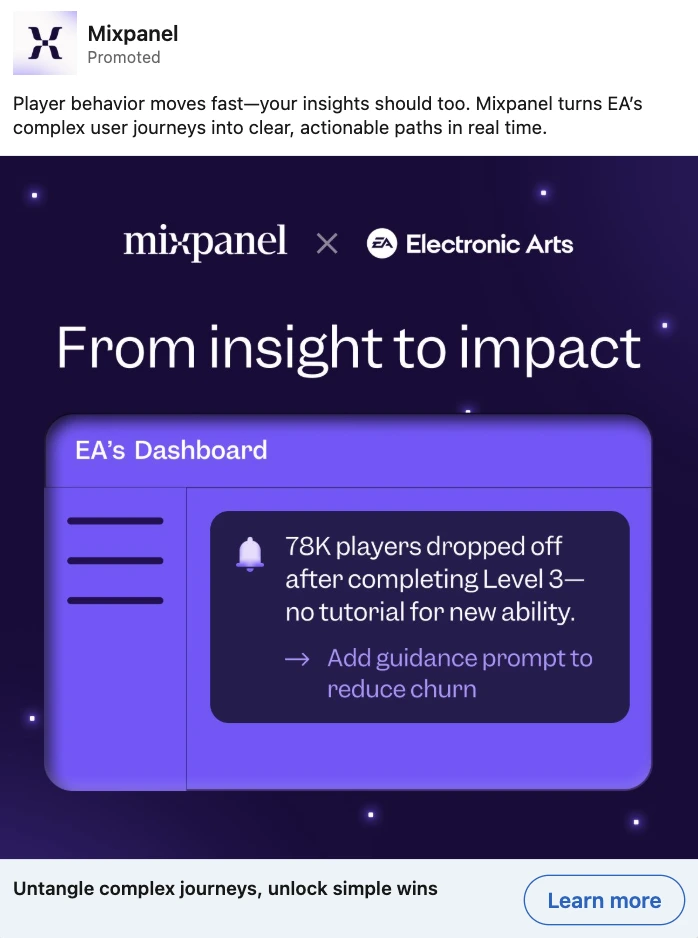
Mixpanel
Objective: Thought leadership and brand credibility
Ad format: Static creative with brand partnership
Why it works: The Mixpanel and Electronic Arts co-branding instantly establishes credibility. The ad moves from insight to outcome using real user data (78K drop-offs) and ties it to actionable value. The use of a dashboard visual also helps visualize Mixpanel in action. This type of ad has highh shareability among product and data teams. It further demonstrates technical depth in a simple format.
What you can learn: Partner-led case studies with data-backed insights make strong thought leadership ads. Showing the problem and resolution clearly in one frame levels up both the brand and the product.
5. Duolingo – Product experimentation
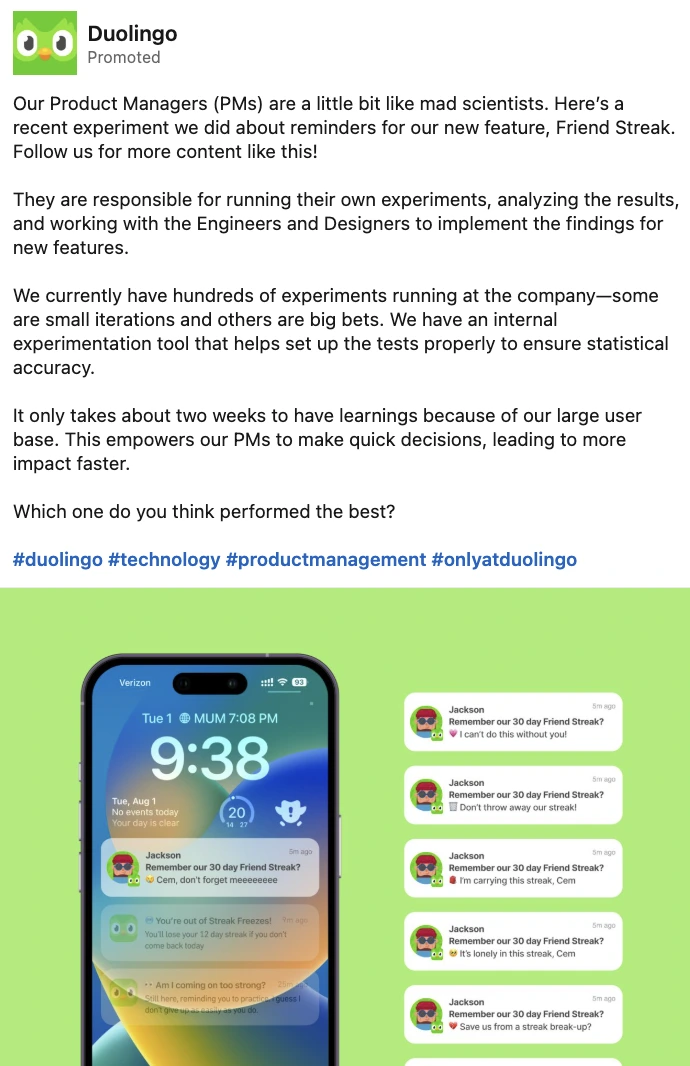
Duolingo
Objective: Brand affinity and recruitment storytelling
Ad format: Story-led image ad with native screenshots
Why it works: The ad taps into the internal culture and experimentation practices of Duolingo, making it both employer branding and product marketing. The tone is playful, and the screenshots of push notifications offer a glimpse into real features. This type of post has high engagement and comment potential, especially from PMs and tech talent. The “Which one performed best?” prompt encourages interaction.
What you can learn: Ads that pull back the curtain and show BTS or “how we work” can attract talent and build loyalty among product-driven audiences.
6. Replit – AI app builder
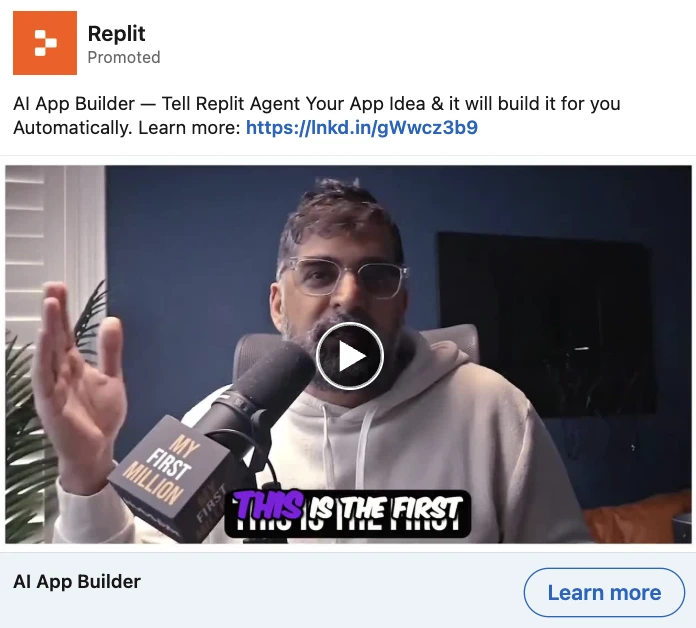
Replit
Objective: Product launch and demo acquisition
Ad format: Video ad (talking head interview-style)
Why it works: Uses a familiar podcast clip aesthetic with subtitles and a casual tone. This format blends organic and paid, creating high relatability. It's short, spoken, and direct—ideal for high-scroll environments like LinkedIn. This type of ad performs well among builders, developers, and early adopters who respond to peer tone and product simplicity.
What you can learn: Talking head clips (especially with subtitles and minimal editing) can feel native and informal which is great for launching technical products with low-friction context.
7. Notion – Simplify your stack
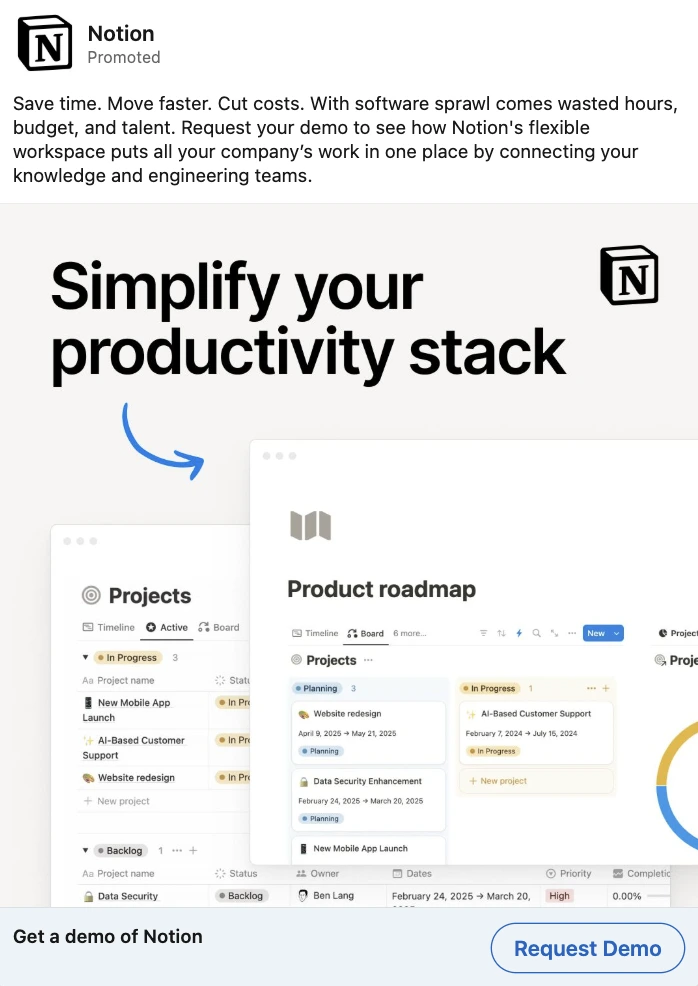
Notion
Objective: Demo conversion for enterprise productivity tools
Ad format: Static image ad with layered UI screenshots
Why it works: The ad speaks directly to decision-makers in ops and engineering. "Simplify your productivity stack" is a clear benefit-led hook. The supporting text frames a demo as the answer to platform sprawl — an increasingly common problem. This type of ad has high conversion potential with companies evaluating tools. Direct “Request demo” CTA aligns with bottom-of-funnel intent.
What you can learn: Lead with a top-level pain (software sprawl), follow with a role-specific benefit (fewer tools, more focus), and end with a frictionless CTA.
8. Chili Piper – Social proof from real user
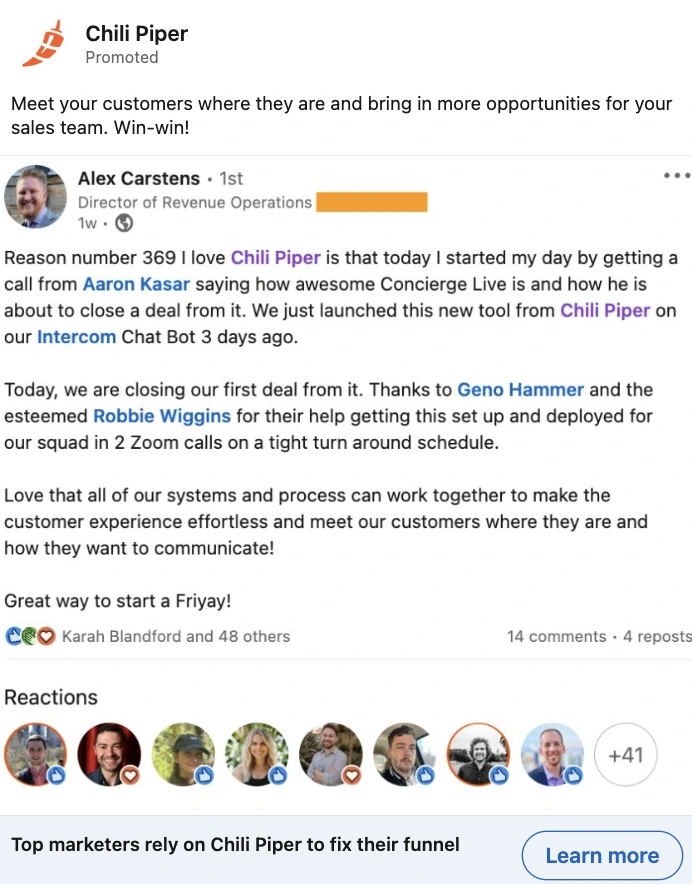
Chili Piper - ad with UGC
Objective: Mid-funnel conversion through testimonial credibility
Ad format: Thought leader ad (sponsored user-generated post)
Why it works: This is a real customer post, used as an ad or user-generated content by the brand. It’s packed with names, anecdotes, tools, and a real deal win making it one of the strongest social proof assets possible. This type of ad drives high trust factor and is excellent for validation-stage buyers who need “proof it works.” Also likely to perform well in retargeting sequences.
What you can learn: Promote actual user content, not just case studies. The natural language, tagging, and casual tone outperform polished testimonials.
9. Chili Piper – Old way vs. new way
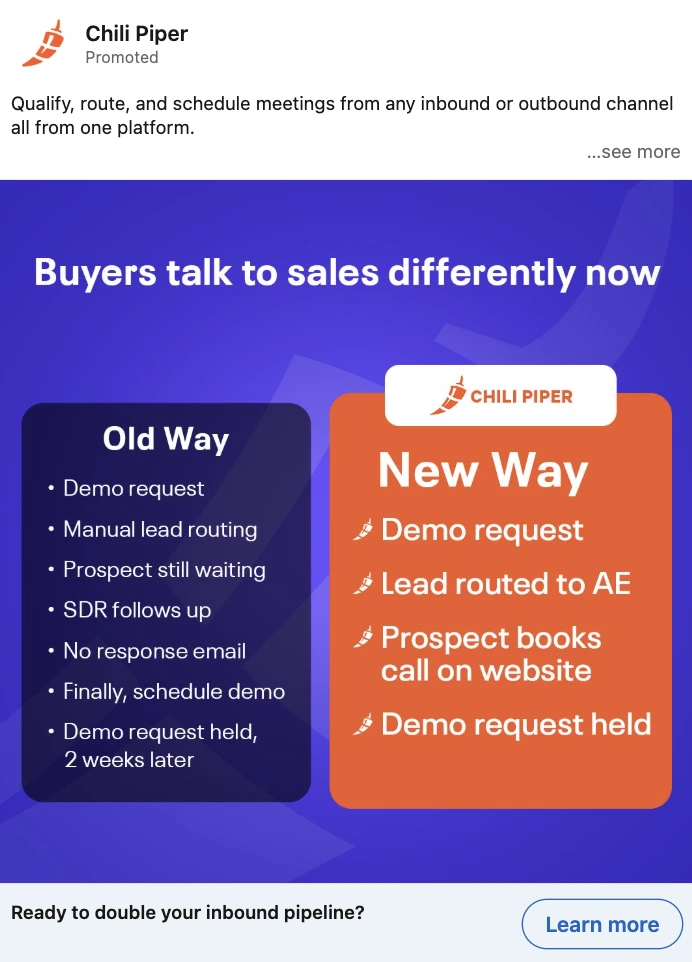
Chili Piper
Objective: Feature positioning and re-education of the problem
Ad format: Comparison-style image ad
Why it works: The split-view “Old Way vs. New Way” format is a classic framework that works because it’s visual, digestible, and emotional. The old way looks frustrating; the new way looks clean and modern. This type of ads are excellent for re-engaging warm leads or explaining new features quickly. This also supports high scan-to-click behavior.
What you can learn: Use contrast-based framing to clarify product value. The “before vs. after” structure makes the benefit obvious without needing paragraphs of explanation.
10. Vault (now Venn) – Better business banking (Kaya’s work)
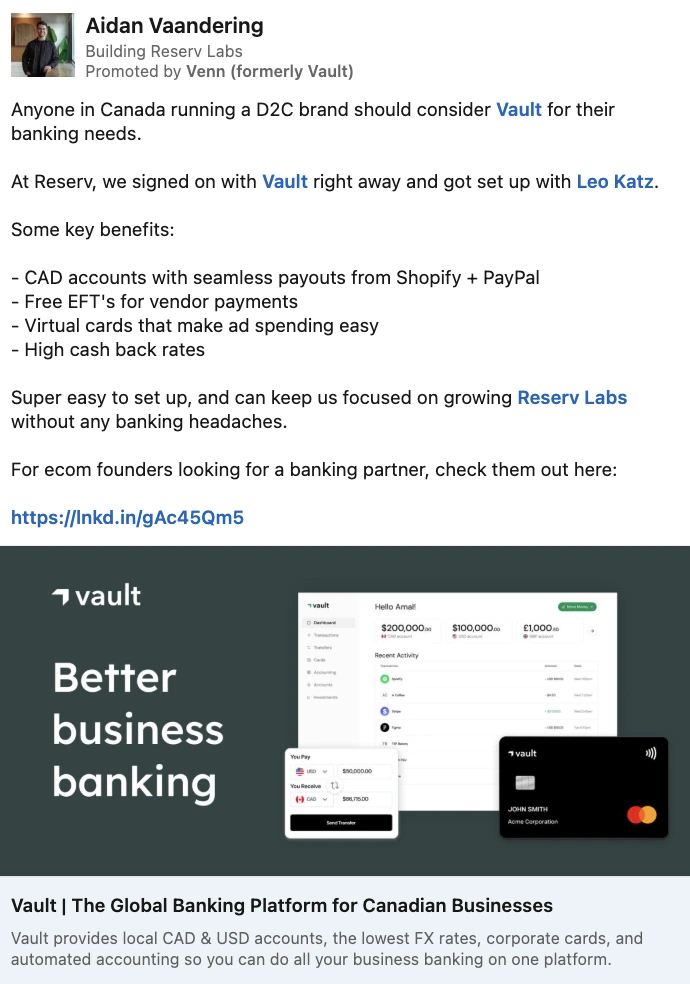
Venn - A Kaya Client
Objective: Social proof and niche targeting for product adoption
Ad format: Thought leader ad + static image
Why it works: This ad feels like a real founder recommendation, not a brand pitch. The copy names specific benefits (CAD accounts, Shopify payouts, ad-spend cards) that are highly relevant to D2C founders in Canada. It’s written in a personal, casual tone and tags teammates, which increases authenticity. This type of ad performs well in cold and warm campaigns targeting early-stage ecommerce founders. The phrase “super easy to set up” reduces friction and builds urgency.
What you can learn: A user-endorsed ad written in ICP language, with a clear vertical (Canadian ecommerce) and tangible product outcomes, can outperform polished sales copy. List-style benefits and brand tags help build trust.
11. Classet – Integrate AI into your hiring (Kaya’s work)
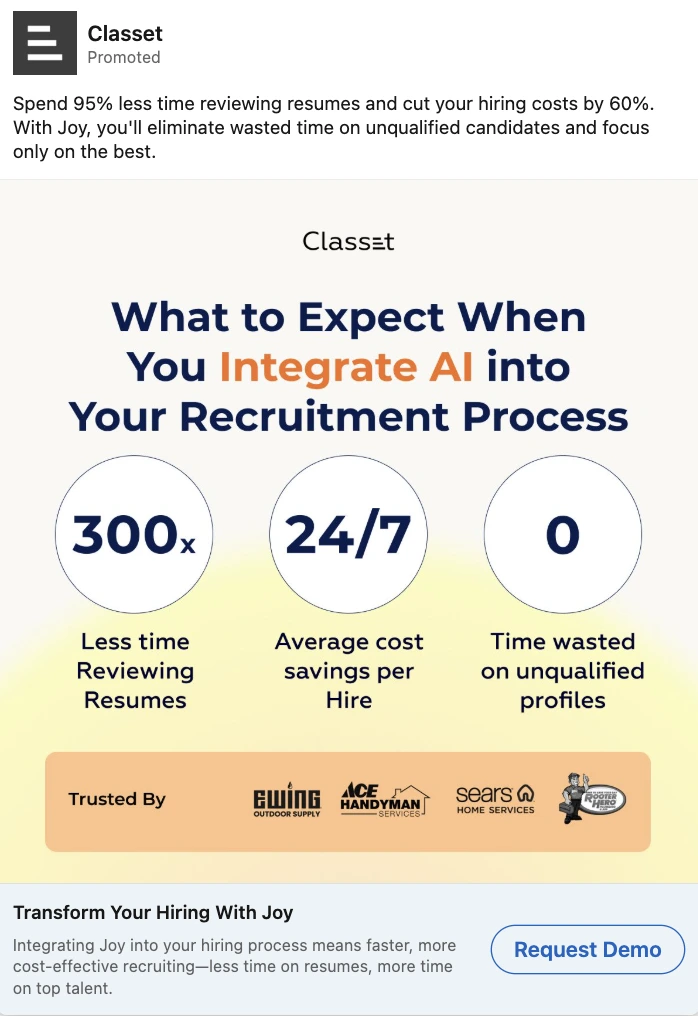
Classet - A Kaya client
Objective: Product education and lead generation through demo requests
Ad format: Single image with a statistics-led visual ad
Why it works: The headline is framed like a benefits-led guide (“What to Expect…”), which is rare in B2B ads and highly clickable. The visual simplifies the product value into three clear outcomes, backed by numbers. Highlighting 300x time saved and 60% cost reduction speaks directly to HR decision-makers under pressure. This type of ad shows strong demo conversion from operational and HR personas. The stat-heavy format grabs attention fast and primes the viewer for CTA.
What you can learn: Turning your product promise into quantified outcomes works especially well in crowded or commoditized categories. Adding recognizable logos (trusted by…) signals stability.
Tools and techniques to view LinkedIn ad examples
The smartest founders and media teams rarely ideate LinkedIn ads from scratch. They study what’s already working and adapt high-performing patterns so that they can avoid wasting time on ideas that won't scale.
Here’s a list of the best free and paid tools to help you explore real LinkedIn ad examples, uncover competitor strategies, and build creative that stands out.
1. LinkedIn Ad Library (Free)
LinkedIn has one of the most comprehensive ad libraries. Visit any company’s LinkedIn Page and click the “Ads” tab. You’ll see every active ad they’re running — whether it’s a carousel, document, or thought leader post.
While you won’t get performance metrics, it’s still great for:
- Studying creative formats and copy structure
- Spotting trending messaging themes in your industry
- Getting real-time inspiration for your next test
Use this free resource to build a swipe file of competitors’ positioning and CTAs.
2. COIN by Kaya (Free and Paid)
If you're serious about improving your LinkedIn ad performance, competitive context is essential. You need to know what others in your space are saying, how they’re positioning their offers, and where they’re focusing their ad budgets. Competitor Ad Intelligence Tool (COIN) by Kaya is one of the few tools that does this well, especially if you're managing paid campaigns across multiple platforms, not just LinkedIn.
While many competitor research tools offer bloated dashboards or generic creative galleries, COIN focuses on delivering practical and actionable insights. It’s purpose-built for founders, growth marketers, and media teams who care less about vanity metrics and more about differentiating copy and creative. Here are a few things you can do using COIN:
-
View multi-platform ad activity
See which ads your competitors are running across LinkedIn, Meta, Google, TikTok, and Bing — all in one place. This eliminates the need to jump between separate ad libraries and screenshots manually.
-
Understand creative patterns and messaging tests
COIN brings together real examples of how your competitors are experimenting with creative formats, headline hooks, value props, and CTA types. This helps you avoid repeating oversaturated angles and gives you language frameworks to test yourself.
-
See where competitors are focusing
Get a directional sense of where brands are putting the most spend and effort. Are they heavily investing in LinkedIn or are they exploring other platforms as well? What is the most common ad format? Knowing these would help you make better decisions.
-
Get clear, lightweight reports
COIN delivers focused intelligence, often via easy-to-read, shareable reports. No clutter, no dashboard fatigue, just the key takeaways you actually need.
COIN is ideal if you're a founder or paid media lead who:
- Needs to get up to speed quickly on competitor messaging
- Wants to brief a creative or copy team with real-world context
- Is tired of generic ad scraping tools that don’t surface strategy-level insight
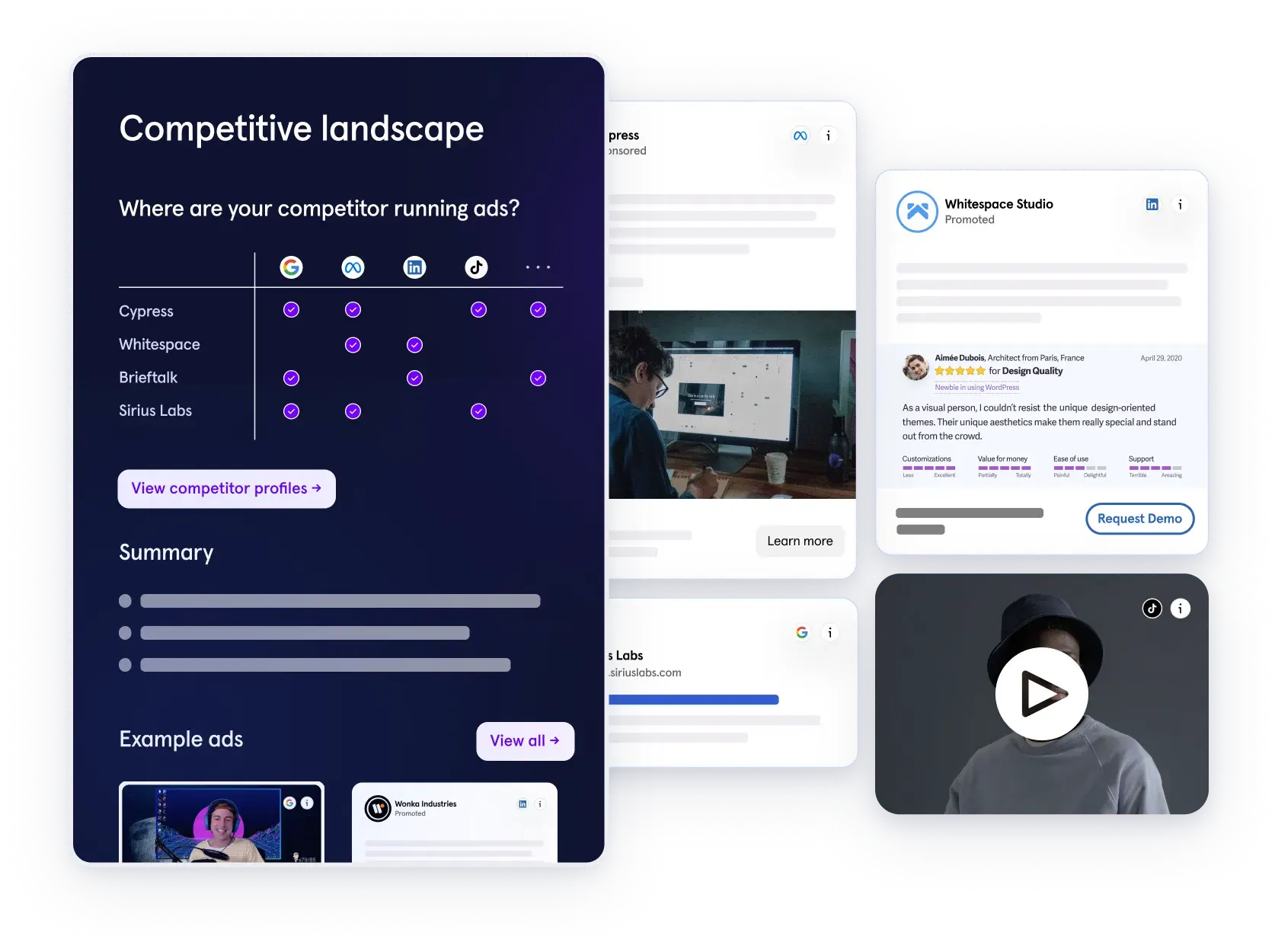
Competitor Ad Intelligence Tool - COIN
3. Motion (Paid)
Motion is a creative performance platform trusted by teams at Notion, Miro, and Air. While it’s best known in DTC, it’s powerful for B2B marketers running LinkedIn ads at scale.
Motion helps you:
- Analyze top-performing hooks, angles, and content themes
- Spot creative fatigue early using ad-level engagement trends
- Organize creatives by performance, format, and offer type
- Write better briefs backed by actual creative analytics
It’s less about ad discovery and more about creative iteration and optimization. This makes it perfect for Series A+ teams building creative ops.
4. AdSpyder (Paid)
AdSpyder covers ads across platforms like Google, LinkedIn, YouTube, and Instagram. It's a good tool if you're benchmarking competitor keyword usage and ad spend trends across channels.
Features include:
- Competitor ad history
- Daily ad monitoring
- Platform-specific search filters
- Integration with competitor landing pages and domains
This tool is great for marketers who want more than creative snapshots e.g. tracking how ad messaging aligns with page-level offers.
5. BigSpy (Free & Paid)
BigSpy scrapes ads from multiple platforms and works well for top-of-funnel research. You can search by keyword, advertiser, or platform including LinkedIn.
It’s not as tailored as COIN or as polished as Motion, but it’s helpful for:
- Finding niche B2B LinkedIn ad examples globally
- Filtering by industry and creative type
- Quickly scanning creative trends in volume
This is best used for broad idea generation, not deep competitor analysis.
6. SwipeWell (Free & Paid)
While not an ad intelligence tool per se, SwipeWell lets you create your own structured swipe file. You can:
- Save and tag LinkedIn ads by format, funnel stage, CTA, etc.
- Collaborate with team members
- Filter swipes for specific use cases (e.g., lead gen CTAs, testimonial-based hooks)
If your team already studies ads manually, this makes your inspiration process more searchable and repeatable.
Bonus Tip: Build your own “ad intelligence stack”
Combine these tools based on your workflow:
- Use LinkedIn Ad Library for real-time monitoring
- Use COIN to understand competitive ad strategy
- Use BigSpy or AdSpyder to explore widely or supplement when budgets are tight
How can I target the right audience on LinkedIn?
You can have the most brilliant ad creative and a world-class offer. But if the wrong people are seeing it, you’re just burning the budget.
This is where LinkedIn’s targeting capabilities set it apart from every other ad platform.
Unlike Meta or Google, LinkedIn gives you access to professionally verified data: job titles, company size, industry, seniority, skills, interests, degrees — you name it. And that’s exactly what makes it so powerful, especially for B2B marketing.
But here’s the catch: the deeper the targeting options, the easier it is to overcomplicate and over-narrow your campaigns.
So let’s simplify this.
1. Start with your ICP, not job titles
Too many early-stage companies start with “who might be interested” instead of “who’s most likely to take action.”
Before you open Campaign Manager, answer these:
- What is our Ideal Customer Profile (ICP)?
- What job titles typically champion or buy our product?
- What size companies or industries do they work in?
- What business problem are we solving for them?
This exercise forces clarity. It aligns your ad with a specific decision-maker and ensures your message speaks directly to their daily challenges. It also reduces waste. Because LinkedIn clicks are expensive, and vague targeting leads to low-intent traffic.
Here’s an example to add more clarity:
If you're selling a B2B payments tool, your ICP might be finance managers or controllers at mid-market ecommerce brands (50–500 employees). That already defines your target by job function, seniority, industry, and company size.
2. Layer targeting options intentionally
LinkedIn offers targeting by:
- Job titles (e.g., Head of Marketing, VP Finance)
- Functions (e.g., Marketing, Finance, Product)
- Skills (e.g., demand generation, SQL, B2B SaaS)
- Seniority (e.g., Entry, Manager, Director, VP, CXO)
- Company size (e.g., 11–50, 51–200, 201–500)
- Industries (e.g., Internet, Computer Software, Financial Services)
- Groups and interests (e.g., Revenue Collective, Web3 Builders)
Each layer adds precision. But too many layers can choke delivery and over-segment your audience. The goal is balance: precise enough to reach the right people, but broad enough to scale and gather performance data.
3. Use "Job function + seniority" as a flexible fallback
Job titles can be messy. Different companies call the same role different things (e.g., “Growth Lead” vs “Performance Marketing Manager”). Relying too heavily on titles alone risks missing large chunks of your target audience.
If you're not sure what titles to use, start with:
- Job function = Marketing
- Seniority = Manager, Director, VP
This often casts a wider yet still relevant net, making it a great approach for campaigns where you want volume without sacrificing intent. It also gives LinkedIn’s algorithm more room to optimize delivery and find conversion-prone clusters.
4. Use “Matched Audiences” for warm targeting
Once you’ve run a few campaigns or built organic traffic, take advantage of Matched Audiences:
- Website visitors (using the LinkedIn Insight Tag)
- Customer email lists (upload or sync from CRM)
- Video viewers (e.g., watched 75% of your awareness ad)
- Lead Gen Form openers or partial completes
These audiences already know you. That makes them far more likely to convert because you’re not educating them from scratch. It also shortens the sales cycle and boosts return on ad spend (ROAS).
5. Avoid over-narrowing your audience
If your audience size drops below 50,000, LinkedIn will flag it as “too small” and may struggle to deliver. That’s a common issue with early-stage startups trying to be ultra-specific.
Over-segmentation might sound smart, but it often backfires. You end up competing against yourself in auctions, your CPMs rise, and LinkedIn's algorithm has too little data to optimize effectively.
A better approach could be targeting based on clear pain points in your creative and leaving the audience definition a little broader. Let your ad copy do the heavy lifting by calling out the right people (“If you manage budgets for an ecommerce brand…”).
6. Build exclusions to protect your spend
Once you’ve generated leads, exclude them from future awareness campaigns using:
- CRM-synced email lists
- “Completed form” audiences
- Website visitors who hit the “Thank You” pages
Why? Because remarketing to converted users wastes impressions and clutters your funnel. Exclusions help you focus on new leads, keeping acquisition costs low and campaign efficiency high.
It’s one of the most underrated tactics in early-stage LinkedIn ads and one of the easiest wins once you’re up and running.
Your best creative will underperform if it reaches the wrong people. Instead of obsessing over clever targeting hacks, ground everything in your ICP, test simply, and retarget smartly.
Because on LinkedIn, relevance equals results. And targeting is the bridge between a great message and the right decision-maker.
How to scale using lessons from high-performing LinkedIn ad examples
Once your LinkedIn ads are live and targeting the right people, the next challenge is scale.
How do you get more leads without sacrificing quality or blowing your budget?
Here’s the reality: LinkedIn ads don’t scale through spend alone. They scale through iteration — by continuously improving what works and cutting what doesn’t.
Let’s walk through six proven strategies that high-growth B2B brands use to optimize and scale their LinkedIn ad campaigns.
1. Always be testing and test meaningfully
A/B testing is the foundation of LinkedIn ad optimization but only when done right. Testing too many variables at once (copy, creative, CTA, audience) muddies the results and leaves you guessing. Instead, isolate a single element. Try the same image with two different headlines, or test a stat-led hook against a question-led one. Testing like this gives you clarity, not just data.
2. Refresh creatives before they fatigue
Even high-performing ads decline over time. LinkedIn rewards engagement, so when users stop clicking or interacting, your CTR (Click-through rate) drops, your CPC (Cost per click) rises, and your ad gets deprioritized in the auction.
3. Double down on top-performing formats
Different formats excel at different stages of the funnel. Carousel ads are great for storytelling, education, and step-by-step breakdowns. Video ads build awareness and retargeting pools. Lead Gen Forms convert best when paired with value-heavy offers like guides or templates. Thought Leader Ads build trust by riding the credibility of a personal account.
If your lead gen form ads consistently outperform your video ads in terms of CPL and MQL quality, that’s your signal to scale them. But don’t abandon video altogether; rather use it higher in the funnel to build audience familiarity before asking for conversion.
4. Build creative libraries, not one-off assets
Instead of creating a new ad from scratch each time, reuse and remix what already works. Turn a high-performing blog into a carousel. Break a webinar into video snippets. Use a line from your pitch deck as a Document Ad headline.
This modular approach saves time, maintains message consistency, and scales production without draining your team. Keep a few design templates handy with the same fonts, logo placement, and color palette so that every ad feels on-brand even as the content evolves.
5. Use analytics to make directional calls, not gut-based ones
Performance data is only useful if you know what to look for. Go beyond surface-level metrics like impressions and track actual funnel movement: CTR, CPL, the form opens vs. completions and video view-through rates.
If people are opening your Lead Gen Form but not submitting it, the problem likely isn’t your targeting. It should be the form length, the offer, or the perceived value. Similarly, if video views drop off after 3 seconds, your hook isn’t doing its job.
6. Don’t scale until you’ve hit “signal”
One of the biggest mistakes early-stage teams make is ramping up spend too early. Just because an ad is live doesn’t mean it’s ready to scale. Wait until you’ve seen consistent performance for at least 7–10 days of stable CTR and CPL, and ideally 10+ qualified leads before pushing the budget.
Scaling prematurely resets learning and can cause CPL to spike. Instead, ramp gradually: from $50/day to $75, then $100 while watching for dips in performance along the way.
At the end of the day, ad optimization should be all about building a repeatable process. The best LinkedIn ad examples you’ll see are rarely one-off wins. They’re the outcome of clear ICP alignment, tight creative testing, and performance-backed decisions made consistently over time.
Bonus tips from high-growth B2B brands running LinkedIn ad examples that convert
If you're trying to build a repeatable, high-performing LinkedIn ad engine, the fastest way to shortcut the learning curve is to look at what high-growth B2B brands are doing and how their actual LinkedIn ad examples behave in the wild.
In the last 5 years, we have had the opportunity to serve 70+ B2B brands. Below we have listed our top learnings through managing their campaigns:
1. Make your ads feel like posts, not promotions
If your ad feels like an ad, people scroll past. That’s why brands like Gong, ClickUp, and Loom consistently write copy that reads more like a personal insight or a helpful resource drop than a corporate ad.
Structure your ad like a compelling LinkedIn post. Hook early, deliver value fast, and close with a CTA only after the reader is already interested.
2. Don’t guess the pain point; call it out directly
High-converting LinkedIn ad examples don’t use vague language like “empower your business” or “streamline operations.” They call out specific, uncomfortable pain and offer a concrete next step. If you're a founder, speak like your customer talks on bad days. Name the issue. Agitate it. Then solve it.
3. Use faces and real people to build trust
LinkedIn is a professional network, but that doesn’t mean it’s sterile. Human-centric creatives, especially 1:1 videos, smiling faces, or quote overlays consistently outperform sterile product screenshots. Even if you're early-stage, use the face of your founder, your first customers, or even your team leads. You're not “too small” to be authentic.
4. Mid-funnel retargeting is where the margin lives
Brands that scale LinkedIn efficiently don’t spend most of their budget at the top of the funnel. They use TOFU formats (like video or carousel) to build custom audiences. And then retarget based on specific signals like:
- Watched 50%+ of the video
- Opened but didn’t submit a lead form
- Visited a product or pricing page
Even if your budget is small, carve out 20–30% for retargeting campaigns. These ads feel more personal, are cheaper to convert, and typically close faster.
5. Make your offer ridiculously clear
This is the most common failure point in LinkedIn ad examples: unclear, weak, or irrelevant offers. People don’t click on “solutions”, they click on outcomes. The best-performing ads offer something specific, fast, and frictionless.
- “Download the 12-slide pitch deck that raised $8M”
- “Use this calculator to check your ROAS in 2 clicks”
- “See how top 1% marketers build UTM frameworks (template inside)”
Each of these tells you exactly what you’ll get, in language that implies utility, urgency, and relevance.
Here’s a quick way to evaluate whether your ad is ready or not. Ask yourself: “If I were scrolling 10 pm on a Thursday, would I click this?” If not, the offer probably needs tightening.
TL;DR
- Make your ads feel human and helpful
- Be brave enough to call out the pain point
- Prioritize mid-funnel retargeting
- Lead with clarity and results
- Use content formats that look native, not intrusive
FAQ
How do you run a LinkedIn ad?
What ads do best on LinkedIn?
How to write a LinkedIn message ad?
What is the best format for LinkedIn ads?
Final thoughts
Successful LinkedIn ads don’t happen by accident. The best-performing campaigns are rooted in strong fundamentals such as clear ICP targeting, value-driven messaging, format-to-funnel alignment, and continuous iteration based on performance data.
While great ad examples offer inspiration, their real value comes from understanding why they work and how to adapt those patterns to your own brand, audience, and objectives.
If you want to consistently and efficiently find and learn from high-performing LinkedIn ad examples, the most effective approach is using tools that bring them all into one place. Platforms like LinkedIn Ad Library, COIN by Kaya, Motion, and others save time, surface real strategic insights, and help you write smarter, not just faster.
Let the best ads guide your next move without explicitly copying. Decode, adapt, and build your own repeatable system.


